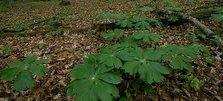
Podophyllum peltatum is most commonly known as the mayapple, but in various regions it is also known as Devil's apple, hog apple, Indian apple, umbrella plant, wild lemon, and American mandrake (though it should not be confused with true mandrake, Mandragora officinarum, an unrelated Old World plant whose roots have been used throughout history for medicines and potions).
The mayapple is a perennial plant in the barberry family (Berberidaceae) which is found in woodlands in Canada and the Eastern U.S. (Eastern being East of Oklahoma). These plants reach 6-18 inches in height and grow in patches. Each plant has a single stalk topped with one or two broad, deeply divided leaves that vaguely resemble umbrellas. The two-leaved plants normally produce a single, small white flower (usually in May, thus the name) from the fork in the stem. The flower develops into a pulpy, lemon-yellow berry which ripens in late summer and is the only part of the plant that isn't poisonous (however, the berries should only be eaten in moderation, if at all).
We had these growing on the home place and daddy always told us they were poison.I see them growing on the hill side here when I turn on to the black top. They are one of the first plant to start growing in the spring.



1 comment:
I have always enjoyed seeing these plants when I've walked through the woods in Spring. The secret bloom underneath is endearing to me.
Once I knew a woman who liked the mayapple so much that she changed her name to May Apple. And it seemed right for her.
Post a Comment